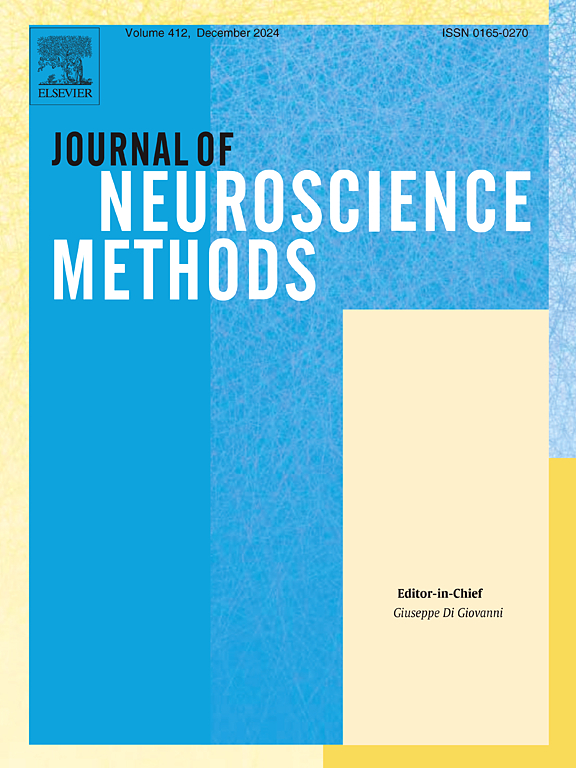Quantifying population-level neural tuning functions using Ricker wavelets and the Bayesian bootstrap
IF 2.7
4区 医学
Q2 BIOCHEMICAL RESEARCH METHODS
引用次数: 0
Abstract
Background
Experience changes visuo-cortical tuning. In humans, re-tuning has been studied during aversive generalization learning, in which the similarity of generalization stimuli (GSs) with a conditioned threat cue (CS+) is used to quantify tuning functions. Previous work utilized pre-defined tuning shapes (generalization and sharpening patterns). This approach may constrain the ways in which re-tuning can be characterized since the tuning patterns may not match the prototypical functions.
New method
The present study proposes a flexible and data-driven method for precisely quantifying changes in tuning based on the Ricker wavelet function and the Bayesian bootstrap. This method was applied to EEG and psychophysics data from an aversive generalization learning paradigm.
Results
The Ricker wavelet model fitted the steady-state visual event potentials (ssVEP), alpha-band power, and detection accuracy data well. A Morlet wavelet function was used for comparison and fit the data better in some situations, but was more challenging to interpret. The pattern of re-tuning in the EEG data, predicted by the Ricker model, resembled the shapes of the best fitting a-priori patterns.
Comparison with existing methods
Although the re-tuning shape modeled by the Ricker function resembled the pre-defined shapes, the Ricker approach led to greater Bayes factors and more interpretable results compared to a-priori models. The Ricker approach was more easily fit and led to more interpretable results than a Morlet wavelet model.
Conclusion
This work highlights the promise of the current method for capturing the precise nature of visuo-cortical tuning, unconstrained by the implementation of a-priori models.
利用里克小波和贝叶斯引导法量化种群级神经调节函数
背景:经验会改变视觉皮层的调谐。在人类的厌恶泛化学习过程中,对重新调谐进行了研究,其中泛化刺激(GSs)与条件威胁线索(CS+)的相似性被用来量化调谐功能。以前的研究利用了预先确定的调谐形状(泛化和锐化模式)。这种方法可能会限制重新调谐的表征方式,因为调谐模式可能与原型功能不匹配:本研究基于 Ricker 小波函数和贝叶斯引导法,提出了一种灵活的数据驱动方法,用于精确量化调谐变化。该方法被应用于来自厌恶泛化学习范式的脑电图和心理物理学数据:结果:Ricker小波模型很好地拟合了稳态视觉事件电位(ssVEP)、α波段功率和检测准确率数据。莫氏小波函数用于比较,在某些情况下更适合数据,但解释起来更具挑战性。由 Ricker 模型预测的脑电图数据中的再调谐模式与最佳拟合先验模式的形状相似:与现有方法的比较:虽然 Ricker 函数模拟的再调谐形状与预定义的形状相似,但与先验模型相比,Ricker 方法得出的贝叶斯系数更大,结果更易解释。与莫莱特小波模型相比,Ricker 方法更容易拟合,得出的结果也更容易解释:这项工作突出了当前方法在不受先验模型实施限制的情况下捕捉视觉皮层调谐精确性质的前景。
本文章由计算机程序翻译,如有差异,请以英文原文为准。
求助全文
约1分钟内获得全文
求助全文
来源期刊

Journal of Neuroscience Methods
医学-神经科学
CiteScore
7.10
自引率
3.30%
发文量
226
审稿时长
52 days
期刊介绍:
The Journal of Neuroscience Methods publishes papers that describe new methods that are specifically for neuroscience research conducted in invertebrates, vertebrates or in man. Major methodological improvements or important refinements of established neuroscience methods are also considered for publication. The Journal''s Scope includes all aspects of contemporary neuroscience research, including anatomical, behavioural, biochemical, cellular, computational, molecular, invasive and non-invasive imaging, optogenetic, and physiological research investigations.
 求助内容:
求助内容: 应助结果提醒方式:
应助结果提醒方式:


